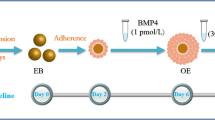Abstract
Recent studies have successfully generated tooth-like structure by mimicking the reciprocal interaction between dental epithelial and mesenchymal cells in tooth organogenesis. However, clinical applications of these methods are limited primarily due to the lack of appropriate sources for dental epithelial cells. Induced pluripotent stem cells (iPSCs) are attractive as a source for dental epithelial cells due to their unique characteristics. In this study, we examined the effect of neurotrophin-4 (NT-4) on the differentiation of mouse iPSCs (miPSCs) into dental epithelial cells. Our results showed that the addition of NT-4 during the formation of embryoid body significantly triggered the upregulation of epithelial markers such as p63 and CK14, suggesting that NT-4 provides an inductive condition for the differentiation of miPSCs into epithelial cells. Expansion of the NT-4-treated cells under serum-free culture conditions improves the formation of cells with cobblestone-like morphology and significantly downregulated the expression of pluripotent and ectodermal markers. Phenotypic analysis revealed that a dental epithelial surface marker, CD49f, was highly expressed on these cells. Formation of miPSCs-derived dental epithelial-like cells was further confirmed by the expression of ameloblast-specific markers. These results suggest that the addition of NT-4 during the formation of embryoid body together with the serum-free culture condition promoted the differentiation of miPSCs into dental epithelial-like cells.




Similar content being viewed by others
References
Arakaki M, Ishikawa M, Nakamura T, Iwamoto T, Yamada A, Fukumoto E, Saito M, Otsu K, Harada H, Yamada Y, Fukumoto S (2012) Role of epithelial-stem cell interaction during dental cell differentiation. J Biol Chem 287:10590–10601
Bluteau G, Luder H-U, Bari CD, Mitsiadis TA (2008) Stem cells for tooth engineering. Eur Cell Mater 16:1–9
Cai J, Zhag Y, Liu P, Chen S, Wu X, Sun Y, Li A, Huang K, Luo R, Wang L, Liu Y, Zhou T, Wei S, Pan G, Pei D (2013) Generation of tooth-like structure from integration-free human urine induced pluripotent stem cells. Cell Regen (Lond) 2:6
Domingues MG, Jaeger MM, Araujo VC, Araujo NS (2000) Expression of cytokeratins in human enamel organ. Eur J Oral Sci 108:43–47
Duailibi MT, Duailibi SE, Young CS, Bartlett JD, Vacanti JP, Yelick PC (2004) Bioengineered teeth from cultured rat tooth bud cells. J Dent Res 83:523–538
Ikeda E, Morita R, Nakao K, Ishida K, Nakamura T, Takano-Yamamoto T, Ogawa M, Mizuno M, Kasugai S, Tsuji T (2009) Fully functional bioengineered tooth replacement as an organ replacement therapy. Proc Natl Acad Sci U S A 106:13475–13480
Iwamoto T, Yamada A, Arakaki M, Sugawara Y, Ono M, Futaki M, Yoshizaki K, Fukumoto E, Nakamura T, Fukumoto S (2011) Expression and functions of neurotrophic factors in tooth development. J Oral Biosci 53:13–21
Medawar A, Virolle T, Rostagno P, de la Forest-Divonne S, Gambaro K, Rouleau M, Aberdam D (2008) Δp63 is essential for epidermal commitment of embryonic stem cells. PLoS One 3:e3441
Mitsiadis TA, Papagerakis P (2011) Regenerated teeth: the future of tooth replacement? Regen Med 6:135–139
Ning F, Guo Y, Tang J, Zhou J, Zhang H, Lu W, Gao Y, Wang L, Pei D, Duan Y, Jin Y (2010) Differentiation of mouse embryonic stem cells into dental epithelial-like cells induced by ameloblast serum-free conditioned media. Biochem Biophys Res Commun 394:342–247
Oshima M, Mizuno M, Imamura A, Ogawa M, Yasukawa M, Yamazaki H, Morita R, Ikeda E, Nakao K, Takano-Yamamoto T, Kasugai S, Saito M, Tsuji T (2011) Functional tooth regeneration using a bioengineered tooth as a mature organ replacement regenerative therapy. PLoS One 6:e21531
Osman H, Kora AS (2006) Immunohistochemical detection of cytokeratin 14 in developing enamel organ of rat molars. Egyptian Dent J 52:1399–1407
Rufini A, Barlattani A, Docimo R, Velletri T, Niklison-Chirou MV, Agostini M, Melino G (2011) p63 in tooth development. Biochem Pharmacol 82:1256–1261
Sakurai M, Hayashi R, Kageyama T, Yamato M, Nishida K (2011) Induction of putative stratified epithelial progenitor cells in vitro from mouse-induced pluripotent stem cells. J Artif Organs 14:58–66
Salmivirta K, Gullberg D, Hirsch E, Altruda F, Ekblom P (1996) Integrin subunit expression associated with epithelial-mesenchymal interactions during murine tooth development. Dev Dyn 205:104–113
Simmons DT, Gu T, Krebsbach PH, Yamada Y, MacDougall M (1998) Identification and characterization of a cDNA for mouse ameloblastin. Connect Tissue Res 39:3–12
Sonoyama W, Liu Y, Fang D, Yamaza T, Seo BM, Zhang C, Liu H, Gronthos S, Wang CY, Wang S, Shi S (2006) Mesenchymal stem cell-mediated functional tooth regeneration in swine. PLoS One 1:e79
Tabata MJ, Matsumura T, Liu JG, Wakisaka S, Kurisu K (1996) Expression of cytokeratin 14 in ameloblast-lineage cells of the developing tooth of rat, both in vivo and in vitro. Arch Oral Biol 41:1019–1027
Takahashi K, Yamanaka S (2006) Induction of pluripotent stem cells from mouse embryonic and adult fibroblast cultures by defined factors. Cell 126:663–676
Volponi AA, Pang Y, Sharpe PT (2010) Stem cell-based biological tooth repair and regeneration. Trends Cell Biol 20:715–722
Yoshizaki K, Yamamoto S, Yamada A, Yuasa K, Iwamoto T, Fukumoto E, Harada H, Saito M, Nakasima A, Nonaka K, Yamada Y, Fukumoto S (2008) Neurotrophic factor neurotrophin-4 regulates ameloblastin expression via full-length TrkB. J Biol Chem 283:3385–3391
Yu KR, Yang SR, Jung JW, Kim H, Ko K, Han DW, Park SB, Choi SW, Kang SK, Schöler H, Kang KS (2012) CD49f enhances multipotency and maintains stemness through the direct regulation of OCT4 and SOX2. Stem Cells 30:876–887
Acknowledgements
This study was supported by Grant-in-Aid for Scientific Research (B) (No. 16H03182), Ministry of Education, Culture, Sports, Science and Technology, Japan.
Author information
Authors and Affiliations
Corresponding author
Additional information
Editor: Tetsuji Okamoto
Rights and permissions
About this article
Cite this article
Abdullah, A.N., Miyauchi, S., Onishi, A. et al. Differentiation of mouse-induced pluripotent stem cells into dental epithelial-like cells in the absence of added serum. In Vitro Cell.Dev.Biol.-Animal 55, 130–137 (2019). https://doi.org/10.1007/s11626-019-00320-z
Received:
Accepted:
Published:
Issue Date:
DOI: https://doi.org/10.1007/s11626-019-00320-z




